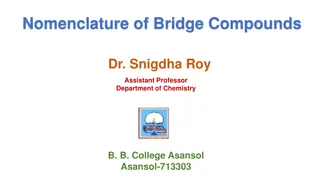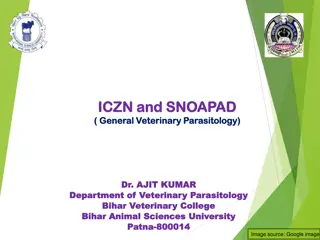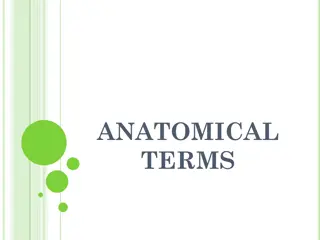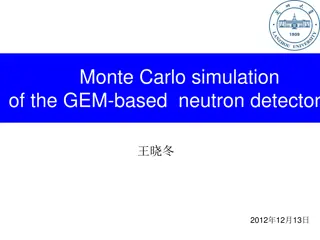ECFA Detector R&D Roadmap and International Collaborations Update
The ECFA Detector R&D Roadmap outlines collaborative efforts in particle physics research, focusing on high-field magnets, muon beams, and more. Task Forces are coordinating community consultations for future experimental programs, with a goal to fulfill strategic needs identified by the ESPP update
0 views • 28 slides
Understanding Tumor Classification and Nomenclature in Pathology
This slideshow provides an overview of tumor classification, nomenclature, and key concepts in pathology. It covers the definitions of neoplasm, tumor, and oncology, the classification of tumors into benign and malignant categories, as well as the importance of stroma in tumor behavior. It also expl
4 views • 61 slides
NNbar Annihilation Detector Mechanical Design Proposal
This proposal outlines the mechanical design considerations for the NNbar Annihilation Detector, highlighting practical concerns and proposed changes to the baseline design. Topics cover the structure support, component weights, installation challenges, and optimizations for improved detector perfor
2 views • 27 slides
Introduction to Theory of Machine Unit I: Simple Mechanisms
Explore the fundamentals of Theory of Machine (MEC-201A) Unit I with Dr. Sandeep, Assistant Professor in the Mechanical Engineering Department. Learn about the introduction to machines, motion classification, kinematic links, nomenclature, constrained motion, kinematic pairs, kinematic chains, and m
8 views • 32 slides
Plant Classification and Nomenclature Explained
Understanding plant classification through taxonomy, identification, and naming processes. Learn about the botanical structures such as roots, venation patterns, flowers, and vascular bundles. Explore the principles of binomial nomenclature, genus, and species differentiation. Discover the diverse s
2 views • 159 slides
Advanced Detector Nomenclature and Proposed Segmentation System
This content provides detailed information on detector nomenclature, parts, and a proposed segmentation system for advanced spectrometers. It includes visuals and explanations of ring, septant, coil, and segment identification within the detector, offering insights into the intricate workings of spe
0 views • 4 slides
Overview of Organic Compounds Nomenclature
Nomenclature of organic compounds involves assigning names based on two main systems - Trivial system and IUPAC system. Trivial system utilizes names related to discoverers or sources, often with Latin or Greek roots. Saturated hydrocarbons, known as paraffins, contain single bonds and are less reac
0 views • 27 slides
Understanding Alcohols: Classification and Nomenclature
Alcohols are categorized into aliphatic and aromatic types based on the structure of the hydroxyl group. Aliphatic alcohols have the OH group attached to an aliphatic carbon chain, while aromatic alcohols have it in the side chain of an aromatic hydrocarbon. Further classification includes monohydri
0 views • 11 slides
Fundamentals of Taxonomy Explained: From Classification to Nomenclature
Taxonomy, derived from Greek roots, encompasses the science of classifying organisms and understanding their variations, evolutionary relationships, and naming conventions. It involves description, identification, classification, and nomenclature of both living and extinct organisms. The practices o
1 views • 39 slides
Understanding Amines in Organic Chemistry: Structure, Nomenclature, and Importance
Amines are organic derivatives of ammonia with a nitrogen atom containing a lone pair of electrons, making them basic and nucleophilic. They play crucial roles in living organisms, such as being building blocks of proteins and constituents of nucleic acids. Learn about the structure, nomenclature, a
2 views • 70 slides
Organic Chemistry Fundamentals: Aldehydes and Ketones
The chapter explores aldehydes and ketones, common classes of carbonyl compounds, the structure of the carbonyl group, and the nomenclature of aldehydes according to the IUPAC system. It discusses the characteristics, bonding, and nomenclature rules associated with these important functional groups
0 views • 22 slides
Discussion on Proposed Nomenclature for IEEE 802.11ba Standard
This document presents a discussion on the proposed nomenclature for the IEEE 802.11ba standard draft amendment, highlighting the need for clarity and consistency in terminology to avoid confusion and specification issues. Various new terms and definitions are suggested for different types of device
0 views • 13 slides
Understanding Aldehydes and Ketones in Organic Chemistry
This chapter discusses carbonyl compounds focusing on aldehydes and ketones. It covers their structural differences, drawing, nomenclature, physical properties, synthesis methods, and nucleophilic attack reactions. Additionally, it includes common classes of carbonyl compounds, naming conventions fo
0 views • 21 slides
Nomenclature of Bridge Compounds in Organic Chemistry
Understanding the nomenclature of bridge compounds is essential in organic chemistry. This involves defining bridge heads, bridges, main ring selection, main bridge heads, main bridges, secondary bridges, and more. The IUPAC nomenclature of bridge systems includes indicating the number of rings usin
0 views • 9 slides
Understanding Naming Rules in Veterinary Parasitology
Explore the essential rules and regulations defined by the International Code for Zoological Nomenclature (ICZN) in the field of General Veterinary Parasitology. Learn about the nomenclature of parasites, scientific naming conventions for genera and species, and the classification of parasites in th
1 views • 14 slides
Aromatic Hydrocarbons: Structure, Aromaticity, and Nomenclature
Aromatic hydrocarbons, with benzene as a key example, possess unique properties due to their highly unsaturated structures. The molecular formula of benzene is C6H6, and it exhibits resonance through a planar structure with sp2-hybridized carbons. To be classified as aromatic, a compound must have a
0 views • 19 slides
Closeout Report: Incremental Design Review of EIC Detector Electronics
Closeout report detailing the progress of the Incremental Preliminary Design and Safety Review of the EIC Detector DAQ and Electronics, along with the Final Design Review of Electronics Components for the ePIC Detector. The report includes responses to charge questions, panel reviews, comments, reco
0 views • 23 slides
Neutrino Detectors for NuStorm: Physics Goals and Detector Requirements
Physics goals for neutrino detectors in the NuStorm project include measuring exclusive neutrino cross sections, supporting long baseline programs, searching for sterile neutrinos, and improving measurements. Detector requirements involve reconstructing neutrino interactions, providing charge and pa
0 views • 21 slides
WP7-DETEC Kick-Off Meeting: Advancing Detector Technologies for Particle Physics
WP7-DETEC is a collaborative initiative focusing on the development of state-of-the-art detector technologies in the fields of nuclear physics and high-energy physics. The kick-off meeting aims to foster cooperation, exchange ideas, and educate young scientists in the field. Activities include sessi
0 views • 7 slides
Detector Technology Group: Research & Development Strategies
The Detector Technology Group focuses on R&D for detector technology, setting schedules to make progress. Discussions include short-term approaches for describing detectors, collaboration participation, and decision-making. Activities at CERN and Fermilab are reviewed to address any missing R&D area
0 views • 8 slides
Innovative n-Type Segmented Inverted Coaxial HPGe Detector Study
Comprehensive characterization of an n-type Segmented Inverted Coaxial Point Contact (ICPC) detector by Heather Crawford at the AGATA-GRETINA collaboration meeting. The study focuses on energy resolution, drift time corrections, azimuthal angle and full position reconstruction, along with in-beam ch
0 views • 29 slides
Anatomical Terminology Evolution: From Latin to Modern Standards
Anatomical terms have evolved over centuries into a unified nomenclature system known as Nomina anatomica. This system, initially based on Latin and Greek words, faced confusion and disagreement among anatomists, leading to revisions and the introduction of modern anatomical terminology. The structu
0 views • 27 slides
Dental Anatomy and Nomenclature by M.E. Mermigas, DDS
Detailed images and descriptions providing insight into dental anatomy, nomenclature, deciduous and permanent teeth, crown and root structure, dentin composition, pulp chamber and canal features, tooth crown characteristics, and individual tooth types (incisor, canine, premolar, molar).
0 views • 40 slides
Fundamentals of Combustion II - Introduction and Nomenclature
This lecture introduces the fundamentals of combustion by discussing reasons for studying combustion, alternative energy sources, and what we aim to understand. It covers different types of flames and provides a comprehensive nomenclature summary for the course, including various parameters and thei
0 views • 32 slides
Challenges and Considerations in Electron-Ion Collider Detector Development
Exploring the development of detector systems for Electron-Ion Colliders (EIC) involves addressing various issues such as detector acceptance for low Q2 and high Q2, unique beam characteristics, and the need for specialized components like bend magnets and polarimeters. Key considerations include po
0 views • 16 slides
Communication Strategies and Reports for Advancing Physics Studies and Detector Concepts at EIC
CERN Yellow Reports provide a platform for sharing impactful work related to CERN, including reports on detectors, technical papers, and new activities. The goal is to advance physics studies and detector concepts in preparation for the EIC, focusing on quantifying physics measurements, implications
0 views • 10 slides
Designing Veto Cosmic Ray Detector for JPET Using GEANT4 Simulations
Creating the Veto Cosmic Ray Detector for JPET involves designing the current version of Veto JPET, incorporating 42 scintillators, detecting 4 GeV cosmic muons, generating cosmic muon distribution, and simulating energy deposition inside the veto scintillators. The process includes particle generat
0 views • 26 slides
Understanding Neoplasia: Characteristics and Nomenclature of Tumors
Neoplasia, or new growth, is characterized by uncoordinated growth exceeding that of normal tissues, persistent growth independent of stimuli, loss of responsiveness to growth controls, and local expansion regardless of host environment. Tumors are classified into benign and malignant categories in
0 views • 36 slides
Understanding Detector Response in SIDIS He3 Experiment
Introduction to analyzing hit and occupancy rates from different particle sources in the SIDIS He3 experiment. Explore the simulation data to determine event rates based on detector channels. Examples include pi0 sources and eDIS from the target. Various occupancy cuts are applied, and thresholds ar
0 views • 22 slides
Detector Safety System (DDSS) for TPC Electronics and Connections to Slow Controls
The Detector Safety System (DDSS) for TPC Electronics involves multiple protection levels including slow controls, PLC-based systems, and fuses/diodes to ensure detector safety. It's crucial to consider these aspects during the design phase as modifications post-design are challenging. The system, d
0 views • 20 slides
Challenges and Common Solutions in Implementing Full Streaming Readout for Sub-Detector Technologies
Implementing full streaming readout with proposed sub-detector technologies and DAQ system concept poses challenges including proper data alignment, risks of data loss, and background noise affecting data rates. The transition point for electronic components from detector-specific to common solution
0 views • 9 slides
Understanding Alcohols: Classification, Nomenclature, and Uses
Alcohols are organic compounds with an -OH functional group attached to a carbon atom. They are classified as primary, secondary, or tertiary based on the carbon the -OH group is bonded to. The IUPAC nomenclature for alcohols involves changing the ending of an alkane to -ol. Alcohols like methanol,
0 views • 11 slides
Understanding Alkenes and Alkynes: Nomenclature, Reactions, and Preparations
Alkenes and alkynes are crucial types of unsaturated hydrocarbons with distinct characteristics. This content delves into their IUPAC nomenclature rules, preparation methods, qualitative tests, and reactions. It also explores naming conventions for alkenes and alkenyl groups, providing a comprehensi
0 views • 32 slides
Understanding Plant Families and Nomenclature in Botany
Explore the diverse world of plant families like DICOTYLEDON, APIACEAE, ASTERACEAE, and FABACEAE, along with the nomenclature principles in botany. Learn about the rich variety of species, economic significance, and naming conventions for plants. Discover the significance of terms like Holotype, Iso
0 views • 8 slides
Understanding Covalent Bonds and Nomenclature
Explore the concepts of covalent bonding, where electrons are shared between atoms, leading to the formation of stable molecules. Learn the nomenclature rules for naming covalent compounds using prefixes and root names. Discover the nature of diatomic molecules and the naming conventions for acids.
0 views • 42 slides
Monte Carlo Simulation of GEM-Based Neutron Detector and Detector Performance Analysis
A detailed exploration of Monte Carlo simulations for GEM-based neutron detectors, investigating their detection efficiency and performance characteristics. Various detector designs and concepts, including multi-layer converters and GEM detectors, are discussed, along with simulation results on sign
0 views • 12 slides
Performance Studies of dRICH Detector at ePIC Experiment
The Electron-Ion Collider ePIC experiment focuses on the performance studies of the dRICH detector for particle identification crucial in various physics channels. The detector features aerogel optimization, SiPM sensors, and test-beam analyses. Key capabilities include different techniques for part
0 views • 28 slides
Installation of Robot-Mounted Detector on DIAD Beamline
Installing a robot-mounted detector on the DIAD beamline for the 2021 MOCRAF Workshop at the ICALEPCS conference. The robot arm holds a diffraction detector for dual imaging and diffraction purposes, ensuring safety for personnel, equipment, and integration into EPICS and GDA systems. Functionality
0 views • 28 slides
Introduction to Aromatic Compounds and Benzene Nomenclature
Learn about aromatic compounds, their resonance in benzene, orbital structure, nomenclature for benzenes, and different types of substituents like monosubstituted and disubstituted benzenes. Explore the stability of aromatic compounds compared to aliphatic ones and understand the nomenclature for va
0 views • 19 slides
Guidelines for Nomenclature of Laboratory Mouse and Rat Strains
Laboratory mice and rat strains have specific nomenclature guidelines to account for their genetic backgrounds and origins. Mouse strains are registered through the Mouse Genome Database, while rat strains are registered through the Rat Genome Database. The use of Laboratory Registration Codes is cr
0 views • 14 slides







































